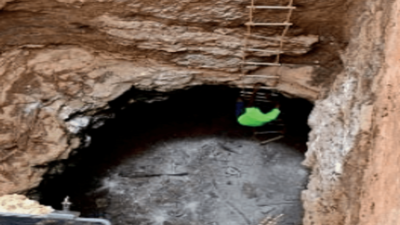- News
- City News
- madurai News
- Gateway to karst aquifer found in Tamil Nadu well that does not fill up
Gateway to karst aquifer found in Tamil Nadu well that does not fill up

The farm well in Thisayanvilai of Tirunelveli district
MADURAI: A modest open farm well in Thisayanvilai in Tirunelveli district is drawing immense attention due to its capacity to devour water even during flash floods. A team of experts from the Indian Institute of Technology - Madras (IIT-M) that studied the 'miracle well', as Ayankulam villagers call it, found that it connects to an underground karst aquifer, which helps it gobble any amount of rainwater that goes into it.
Tirunelveli district administration, with the help of IIT-M, is working on a project to make best use of the karst aquifer, which could possibly extend to about 200 square kilometres in the limestone-rich Thisayanvilai region, to help farmers tap it whenever needed.

During the floods in December 2021, the farmers of Ayankulam were terrified by the well's capacity to absorb flood water. In seconds, massive flash floods, with flows measuring up to 1,000 cusecs of water, used to disappear into the well. Villagers alerted Tirunelveli collector V Vishnu and local MLA and assembly speaker M Appavu.
Officials from the PWD and TWAD Board, after a preliminary study, sought the help of experts from IIT-M to unravel the 'mystery' behind the phenomenon. A team led by Venkatraman Srinivasan from the civil engineering department of IIT carried out a study.
Investigating the phenomenon, they decided to test the feasibility of implementing rapid groundwater recharge technology on a pilot scale. The project was sanctioned by the collector in March 2022.
The IIT team performed four field campaigns and surveyed more than 260 wells in the area. Of them, 163 were selected for monitoring water quality parameters. Water level measurements were also performed to compute groundwater hydraulic gradient. Coordinating with villagers, the team sank 22 bore wells in the study area and soil samples were collected at different depths.
"Based on our study, we have concluded that the Thisayanvilai region, say from Nazareth to Radhapuram, has widespread limestone and calcareous deposits in the surface dominating local hydrology. More than 1,000 years of hydrological process in the porous limestone has led to the formation of a subterranean stream network of interconnected caves and caverns through which water can flow," said Venkatraman, the groundwater scientist from IIT leading the study team. The Ayankulam well could take large quantity of water rapidly because the well has hit the subterranean stream network. During the study, the team found a dozen such wells, he said.
The team has now decided to take up a pilot project of sinking recharge wells to pump surplus water during floods into the underground aquifer. "In the next two months, we plan to sink at least four such recharge wells on a pilot basis. These wells will have sediment filters to prevent any surface contamination reaching the aquifer. These wells will also be provided with silt catchers which the IIT-M will be developing," said collector Vishnu..
Investigating the phenomenon, they decided to test the feasibility of implementing rapid groundwater recharge technology on a pilot scale. The project was sanctioned by the collector in March 2022.
The IIT team performed four field campaigns and surveyed more than 260 wells in the area. Of them, 163 were selected for monitoring water quality parameters. Water level measurements were also performed to compute groundwater hydraulic gradient. Coordinating with villagers, the team sank 22 bore wells in the study area and soil samples were collected at different depths.
"Based on our study, we have concluded that the Thisayanvilai region, say from Nazareth to Radhapuram, has widespread limestone and calcareous deposits in the surface dominating local hydrology. More than 1,000 years of hydrological process in the porous limestone has led to the formation of a subterranean stream network of interconnected caves and caverns through which water can flow," said Venkatraman, the groundwater scientist from IIT leading the study team. The Ayankulam well could take large quantity of water rapidly because the well has hit the subterranean stream network. During the study, the team found a dozen such wells, he said.
The team has now decided to take up a pilot project of sinking recharge wells to pump surplus water during floods into the underground aquifer. "In the next two months, we plan to sink at least four such recharge wells on a pilot basis. These wells will have sediment filters to prevent any surface contamination reaching the aquifer. These wells will also be provided with silt catchers which the IIT-M will be developing," said collector Vishnu..
Tirunelveli district administration, with the help of IIT-M, is working on a project to make best use of the karst aquifer, which could possibly extend to about 200 square kilometres in the limestone-rich Thisayanvilai region, to help farmers tap it whenever needed.

During the floods in December 2021, the farmers of Ayankulam were terrified by the well's capacity to absorb flood water. In seconds, massive flash floods, with flows measuring up to 1,000 cusecs of water, used to disappear into the well. Villagers alerted Tirunelveli collector V Vishnu and local MLA and assembly speaker M Appavu.
Officials from the PWD and TWAD Board, after a preliminary study, sought the help of experts from IIT-M to unravel the 'mystery' behind the phenomenon. A team led by Venkatraman Srinivasan from the civil engineering department of IIT carried out a study.
Investigating the phenomenon, they decided to test the feasibility of implementing rapid groundwater recharge technology on a pilot scale. The project was sanctioned by the collector in March 2022.
The IIT team performed four field campaigns and surveyed more than 260 wells in the area. Of them, 163 were selected for monitoring water quality parameters. Water level measurements were also performed to compute groundwater hydraulic gradient. Coordinating with villagers, the team sank 22 bore wells in the study area and soil samples were collected at different depths.
"Based on our study, we have concluded that the Thisayanvilai region, say from Nazareth to Radhapuram, has widespread limestone and calcareous deposits in the surface dominating local hydrology. More than 1,000 years of hydrological process in the porous limestone has led to the formation of a subterranean stream network of interconnected caves and caverns through which water can flow," said Venkatraman, the groundwater scientist from IIT leading the study team. The Ayankulam well could take large quantity of water rapidly because the well has hit the subterranean stream network. During the study, the team found a dozen such wells, he said.
The team has now decided to take up a pilot project of sinking recharge wells to pump surplus water during floods into the underground aquifer. "In the next two months, we plan to sink at least four such recharge wells on a pilot basis. These wells will have sediment filters to prevent any surface contamination reaching the aquifer. These wells will also be provided with silt catchers which the IIT-M will be developing," said collector Vishnu..
Investigating the phenomenon, they decided to test the feasibility of implementing rapid groundwater recharge technology on a pilot scale. The project was sanctioned by the collector in March 2022.
The IIT team performed four field campaigns and surveyed more than 260 wells in the area. Of them, 163 were selected for monitoring water quality parameters. Water level measurements were also performed to compute groundwater hydraulic gradient. Coordinating with villagers, the team sank 22 bore wells in the study area and soil samples were collected at different depths.
"Based on our study, we have concluded that the Thisayanvilai region, say from Nazareth to Radhapuram, has widespread limestone and calcareous deposits in the surface dominating local hydrology. More than 1,000 years of hydrological process in the porous limestone has led to the formation of a subterranean stream network of interconnected caves and caverns through which water can flow," said Venkatraman, the groundwater scientist from IIT leading the study team. The Ayankulam well could take large quantity of water rapidly because the well has hit the subterranean stream network. During the study, the team found a dozen such wells, he said.
The team has now decided to take up a pilot project of sinking recharge wells to pump surplus water during floods into the underground aquifer. "In the next two months, we plan to sink at least four such recharge wells on a pilot basis. These wells will have sediment filters to prevent any surface contamination reaching the aquifer. These wells will also be provided with silt catchers which the IIT-M will be developing," said collector Vishnu..
FOLLOW US ON SOCIAL MEDIA
FacebookTwitterInstagramKOO APPYOUTUBE
Start a Conversation
end of article










